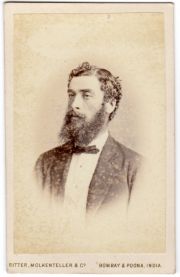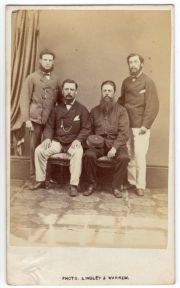John Standfield (1838-1890) of Standfield and Clark
1838 July 23rd. Born in King’s Newnham, Warwickshire, the son of John Standfield, and Engine Driver, and his wife Maria Greasley
1873 John Standfield was already well known for his work in the design and building of pontoon-type bridges when he joined forces with Edwin Clark, to form Standfield and Clark
1881 Living at 44 Lillieshall Road, Clapham: John Standfield (age 42 born Kings Newnham, Wks), Civil Mechanical Engineer. With his wife Phoebe F. Standfield (age 39 born Sittingbourne) and their three children; Frank Standfield (age 14 born London); Amy Standfield (age 12 born Wandsworth); Edith Standfield (age 7 born Clapham). Aslo his nephew Norman G. Smith (age 4 born Lydney). One servant.[1]
1890 Obituary [2]
JOHN STANDFIELD was born at King’s Newnham, Warwickshire, on the 23rd of July, 1838. His early professional experience was gained in Canada, where he was employed on the construction of the Grand Trunk Railway, chiefly in connection with the Victoria Bridge, Montreal.
On returning to England in 1861, he had the superintendence of sinking the caissons for the foundations of the London, Chatham and Dover Railway Company’s Blackfriars Bridge; and in 1864-66, Peto and Betts entrusted him with the same duties on the widening of the Victoria Railway Bridge at Pimlico. Mr. Standfield subsequently had charge of Mr. Rammel’s Pneumatic Railway under the Thames from Waterloo to Whitehall, but on the abandonment of the works he devoted his time to the study and development of various inventions, which he afterwards turned to account, until in April 1869 he proceeded to Bombay, as Resident Engineer for Edwin Clark‘s hydraulic lift graving-dock at Hog Island, which work he successfully carried out, returning to England in 1872.
Shortly after this, Mr. Standfield entered into partnership with Latimer Clark, and devoted himself more particularly to the study and improvement of floating-docks and hydraulic canal-lifts, and, in conjunction with Mr. Clark, became the inventor and patentee of several novelties in connection with this branch of engineering. The most important of these inventions were: the gridiron depositing docks, constructed for the Russian Government, at Nicolaieff, on the Black Sea, and at Vladivostok, the designs for which Mr. Standfield submitted and explained to the late Emperor of Russia ; a gridiron depositing-dock at Barrow-in-Furness; hydraulic canal lifts erected at Fontinettes, near St. Omer, in France, and at La Louvidre, in Belgium; and the off-shore dock, the first of which was built at Standfield and Clark‘s engineering works, at Grays, Essex, and was launched and towed to Cardiff in June 1887 ; a second dock of the same class was afterwards laid down, from Mr. Standfield‘s designs, at Hamburg, and is believed to be the most rapidly worked floating-dock in existence.
Mr. Standfield also gave much attention to the raising and recovery of sunken vessels, and exhibited working models of his patent appliances to H.R.H. the Prince of Wales at the Westminster Aquarium. He was applied to by the owners of the SS Austral, of the Orient Line, a vessel of 5,588 tons register, when she sank while coaling in Sydney Harbour in 1882, and succeeded in raising her without injury. Mr. Standfield contributed a Paper on this work to the Institution, for which he was awarded a Telford premium.
It was, unfortunately, in connection with this class of operations that his useful and energetic career was brought to a premature close, at the age of fifty-one.
In 1888 the SS Ville de Calais, a petroleum tank vessel, exploded and sank in Calais Harbour, and Mr. Standfield some time afterwards purchased the wreck, with the view of raising the undamaged portion which contained the engines and boilers.
This, after a considerable expenditure of time and money, he succeeded in doing, after cutting off the damaged bow-portion of the steamer and building a bulkhead across her. On Saturday evening, March 1st, 1890, she was got under steam, and also taken in tow by a powerful tug, with the intention of bringing her to England. Early on Sunday morning, 2nd March, a sudden storm arose, and, breaking away from the tug, the vessel became unmanageable; an attempt was made to leave her in a boat, which capsized in lowering, and Mr. Standfield and three of the crew lost their lives. The vessel shortly afterwards foundered about a mile off Margate. Mr. Standfield's body was recovered the following morning off Deal, and was interred at Norwood cemetery on the 8th of March.
Mr. Standfield was elected a Member of the Institution on the 22th of April, 1881.
See Also
Sources of Information
- ↑ 1881 Census
- ↑ 1890 Institution of Civil Engineers: Obituaries




